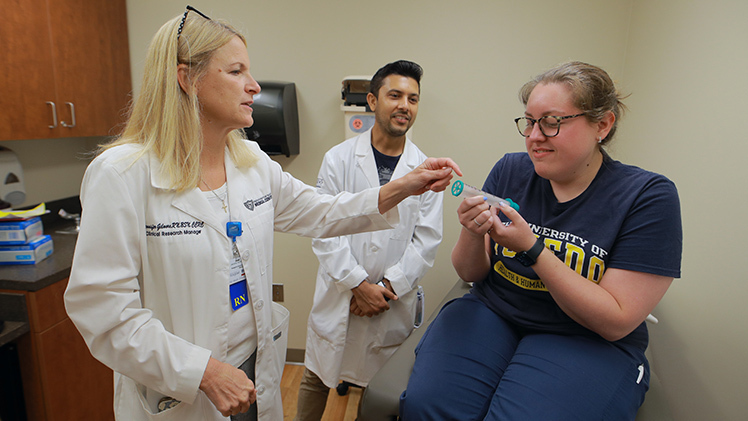A team of clinical and academic researchers at The University of Toledo are embarking on a first-of-its kind study to identify the health effects of airborne microcystin exposure in individuals who spend significant time near Lake Erie.
The Great Lakes Aerosol Monitoring Research Study, which launched this month, will follow 200 individuals from Lucas, Ottawa and Sandusky counties over the next five years.

Jennifer Gilmore, left, a clinical research manager in the UToledo Department of Medicine, demonstrates one of the lung screening devices that will be used in the Great Lakes Aerosol Monitoring Research Study as Katie Behrens, a research clerical assistant in the Department of Medicine, plays the role of a patient.
UToledo researchers will meet with study participants three times annually: before, during and after the lake’s peak harmful algal bloom season, which generally runs from August to early September.
At each of those sessions, researchers will conduct a qualitative health survey and administer several non-invasive tests to assess lung function. Participants also will have the option of submitting blood, urine and nasal brush biopsies for further analysis.
The Great Lakes Aerosol Monitoring Research Study, which is open to individuals aged 10 and older who live, work or recreate within a half-mile of Lake Erie, is enrolling participants now.
Microcystins are a group of toxins produced by cyanobacteria, commonly known as blue-green algae. Microcystin is a recognized liver toxin that emerging laboratory research has shown can impact a range of other organ systems as well, notably including the lungs.
Though much of the focus on preventing exposure to microcystin has been placed on avoiding physical contact with water during harmful algal blooms, Dr. Steven Haller, an associate professor of medicine at UToledo, said there is strong evidence that the toxin can also become airborne as waves crash against the shoreline.
How those aerosolized toxins may be affecting people who spend time near or on the lake is yet to be fully understood.
“We hear questions directly from UToledo clinicians about the potential effects of microcystin exposure. Is it having a seasonal effect on their asthma patients, for example. The simple answer is we don’t know,” said Haller, who is leading the new research project. “This study should begin to answer some of those questions and give us all a better idea of who may be susceptible to the toxins produced during harmful algal blooms.”
The Great Lakes Aerosol Monitoring Research Study is a key part of a recently awarded five-year, $6.5 million federal grant that funds the Great Lakes Center for Fresh Waters and Human Health.
Led by the University of Michigan and UToledo, the Great Lakes Center for Fresh Waters and Human Health includes faculty researchers from nearly a dozen universities and focuses on questions related to the effect of climate change on harmful algal blooms and how toxins produced during those blooms affect human health.
In addition to the prospective health study, Dr. David Kennedy, an associate professor of medicine at UToledo and the center’s co-director, said UToledo will be deploying specialized aerosol sensors to quantify toxin levels in the air.
Kennedy said the current plan is to have one monitor at UToledo’s Lake Erie Center and another mobile-based module that can be deployed at sites throughout the western Lake Erie basin.
The findings from those sensors will help guide future experiments using new, cutting-edge lab equipment that allows researchers to study how human lung cells respond to aerosolized toxins at specific levels.
“We have made significant progress in characterizing the different types of microcystin toxins and their potential affects, but that’s mostly been done in animal cells in culture,” Kennedy said. “We have to extrapolate from that — this is what we see in the lab, so we think this is what might be going on. These new studies will give us the ground truth.”
Other projects at the research center will include a study of how cyanobacteria release their toxins and become airborne, research into how climate change is influencing the proliferation of harmful algal blooms and the toxins they produce and an investigation aimed at identifying new cyanobacterial toxins within the Great Lakes.